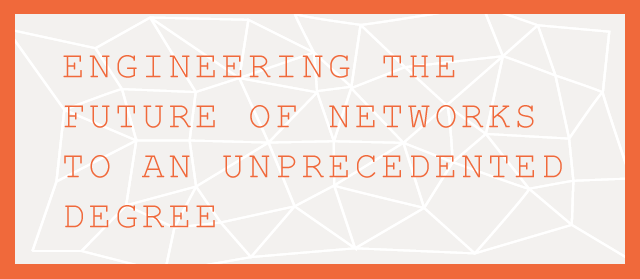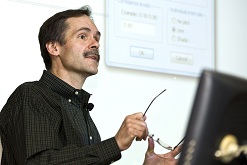
To earn a bachelor of science in engineering from Penn, you’ll draw upon the physical, economic, computer and social sciences, as well as mathematics and engineering. You will also launch a profoundly integrated yet specialized program for this rapidly developing field.
Foundational courses in mathematics like calculus, linear algebra and probability join the basics of engineering with programming, algorithms and stochastic systems analysis. These and more underlie the program’s core classes.
Choose from a wide range of depth
Combined with the fundamentals of Engineering, Mathematics & Natural Sciences, Social Sciences & Humanities,you will choose one of the following five major areas of exploration to complete your NETS degree:
1. Networked and Cloud Services
The Networked and Cloud Services track focuses on tools for building services to rival Facebook or Google, with an emphasis on algorithms, data management, artificial intelligence, software engineering, user interfaces, data visualization and more.
2. Data Science
The Data Science track focuses on techniques that can extract useful information from large amounts of data, as well as on tools for making decisions, understanding observations, and solving problems in today's world. It includes courses on artificial intelligence, machine learning, modeling, and statistics.
3. Theory of Networks and Dynamics
The Theory of Networks and Dynamics track focuses on analysis and design that considers network structure, with an emphasis on optimization, networks, dynamic systems, stochastic processes, decision theory, and more.
4. Economic and Networked Markets
The Economics and Networked Markets track focuses on how institutions like the stock market or other, newer markets are affected by instant digital communication, with an emphasis on network economics, microeconomic theory, algorithmic game theory, entrepreneurship, new media and more.
5. Technology and Society
The Technology and Society track focuses on cutting-edge social-impact questions, like how games and smart phones affect our concentration, or how we bridge the digital divide, with an emphasis on technology and social policy, statistic, demographic computation and surveys.
Fundamental knowledge for shaking society’s foundations
Below are the descriptions of the five courses that comprise the backbone of the NETS program. With both theoretical and practical rigor, these five courses will simultaneously help you develop expansive and granular perspectives of the field’s most pressing issues, as well as give you the tools to make an impact on the future of networks in your own right.NETS 1120: Networked Life
What Will You Learn about?
Networked Life will explore recent scientific efforts to explain social, economic and technological structures -- and the way these structures interact -- on many different scales, from the behavior of individuals or small groups to that of complex networks such as the Internet and the global economy. This course covers computer science topics and other material that is mathematical, but all material will be presented in a way that is accessible to an educated audience with or without a strong technical background. The course is open to all majors and all levels, and is taught accordingly. There will be ample opportunities for those of a quantitative bent to dig deeper into the topics we examine. The majority of the course is grounded in scientific and mathematical findings of the past two decades or less (often much less).NETS 1500: Market and Social Systems on the Internet
What Will You Learn about?
This course gives you an overview of the mathematical and engineering aspects of Market and Social Systems Engineering. We start with a brief overview of graph theory, which helps us abstract networks. Then we look at how sociology and algorithms interact to create online social networks, with a particular emphasis on preferences, recommendations, and connectivity. You'll get a good sense for how Facebook and Google+ do their recommendations. We move on to information networks, where we look at the internals of a search engine like Google or Bing, and discuss how documents are ranked based on their internal properties and the structure of links on the Web. Then we talk about the notions of incentives in network-based interactions, which lead to notions like game theory, markets, auctions, and search keyword pricing (the main source of revenue at Google). Our fourth major topic is the construction of the Internet itself, including how messages are routed. We wrap up with a discussion of the issues in building global-scale systems and services on the Internet.NETS 2120: Scalable and Cloud Computing
What Will You Learn about?
NETS 2120 focuses on a variety of topics relating to data-centric and service-oriented computing. We discuss different types of cloud services; programming models and languages for exploiting thousands of machines to do data processing; AJAX-based “software-as-a-service” platforms such as Node.js; and issues relating to security and privacy in the data-centric computing arena. Students do a variety of hands-on programming and design exercises and a project, running their applications on a commercial cloud provider.NETS 3120: Theory of Networks
What Will You Learn?
This course provides a mathematically rigorous introduction to the study of networks, their structure, function and formation.- Networks. History and motivation for studying networks and networked phenomena. Social networks, small worlds, social science experiments. Central questions in network science, basics of graph theory (Jackson chapter 1)
- Graph theory definitions, adjacency matrix, walks and paths, Laplacian, adjacency and incidence matrix, connectivity
- Perron Frobenius theory, Spectral properties , drawing graphs
- Random graphs, Erdos Renyi model Spectral properties
- Threshold phenomena, branching processes, connectivity in Erdos-Renyi models. Giant components; contagion and diffusion
- Degree distributions, small world model
- Growing random graphs with various degree distributions: power law distributions, preferential attachment, Chung Lu Model
- Network topology identification: Are degree distributions enough?
- Diffusion and contagion models
- PageRank, Poisson equations, effective resistance and random walks
- Gossip and flocking, Krause’s opinion dynamics model
- Game theory and learning in games
- Social learning and distributed parameter estimation in social networks
NETS 4120: Algorithmic Game Theory.
What Will You Learn about?
The list of topics is as follows: Part 1: Game Theory and Game Dynamics- Quick introduction to game theory: Zero sum and general sum games, repeated games, Minmax strategies, Nash equilibrium, correlated equilibrium
- Game Dynamics: Sequential best response, weighted majority algorithm, fictitious play, perturbed follow the leader
- Game Dynamics converging to Nash equilibrium in zero sum games; Game dynamics converging to correlated equilibrium in general sum games
- Price of anarchy: Definition, routing games, hoteling games
- Smooth games and "Price of Total Anarchy"
- Auction basics: First price auctions, second price auctions, truthfulness
- Maximizing welfare: The VCG Mechanism
- Ad Auctions on Google/Yahoo/Bing
- Maximizing revenue: Bayesian optimal auctions: How to set a reserve price
- Maximizing revenue: Prior Free Mechanism Design
- Online auctions for digital goods
- Stable Marriages and the Deferred Acceptance Algorithm
Meet the experts in network exploration
Like the program they helm, the NETS faculty's experience spans multiple disciplines and points of view. Acting as both dedicated researchers and teachers, they merge the theoretical with the practical, ultimately challenging their students to not only be brilliant thinkers, but original ones.NETS Course Planning Guide
The NETS curriculum consists of 37 course units (CUs), including 9 CUs of mathematics and natural sciences, 14 CUs of engineering, 6 CUs of technical electives, 7 CUs of social sciences and humanities, and one free elective. For more details, please click below.






